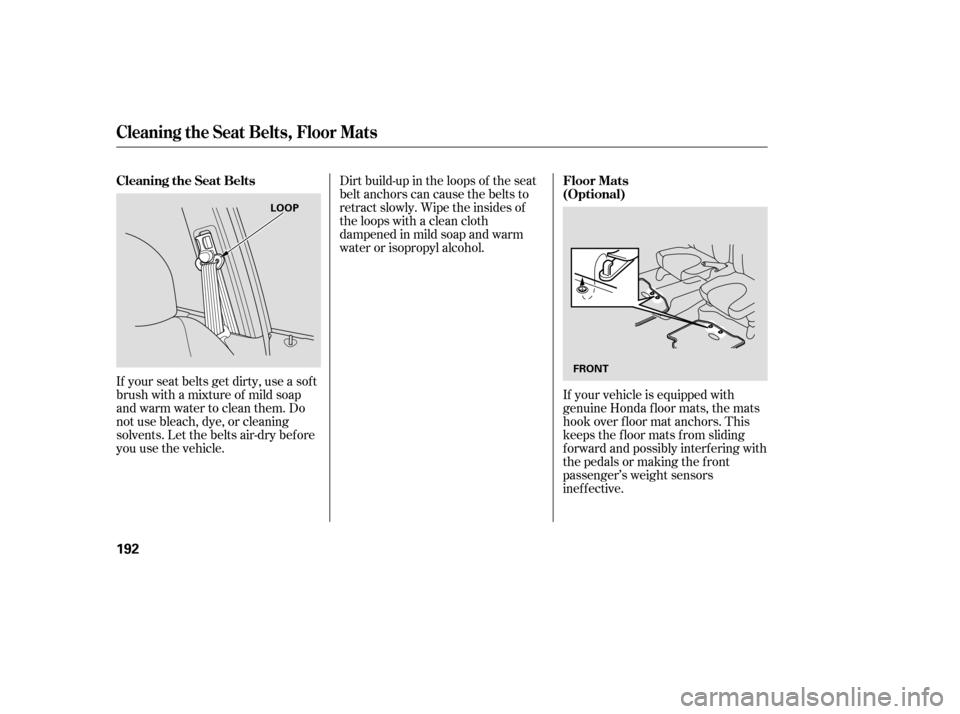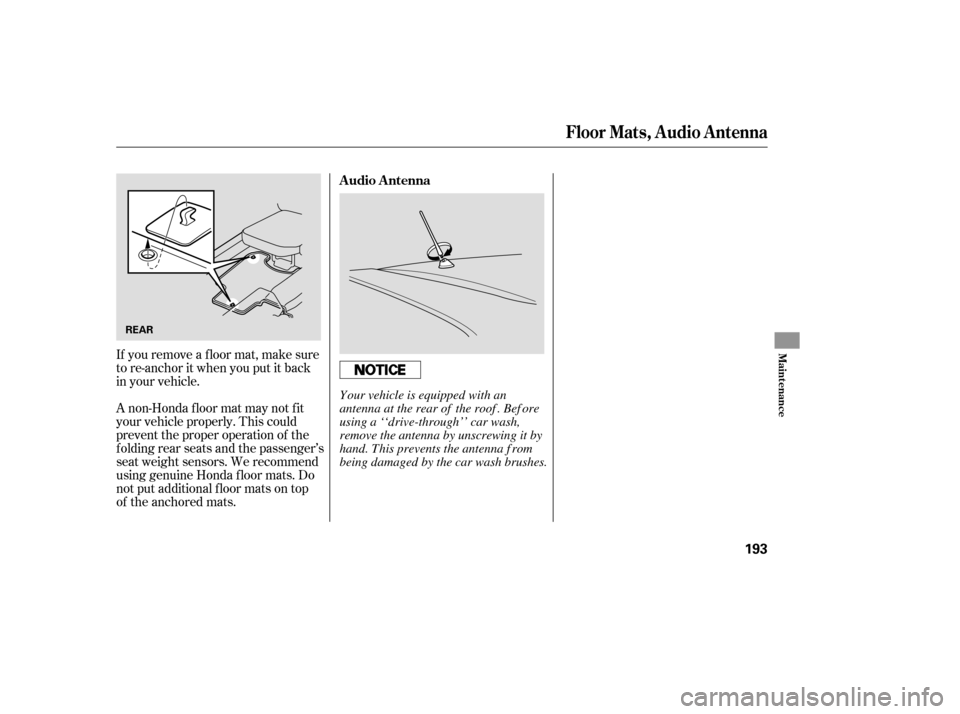sensor HONDA FIT 2007 1.G User Guide
[x] Cancel search | Manufacturer: HONDA, Model Year: 2007, Model line: FIT, Model: HONDA FIT 2007 1.GPages: 258, PDF Size: 3.52 MB
Page 33 of 258

If you see any of these indications,
the airbags and seat belt tensioners
may not work properly when you
need them. This indicator
alerts you that the
passenger’s side airbag has been
automatically shut off. It does
mean there is a problem with your
side airbags.
Wh en you turn the ignition switch to
the ON (II) position, the indicator
should come on brief ly and then go
off(seepage ).Ifitdoesn’tcome
on, stays on, or comes on while
driving without a passenger in the
f ront seat, have the system checked. This indicator alerts you that the
passenger’s f ront airbag has been
shut of f because weight sensors
detect about 65 lbs (29 kg) or less
(the weight of an inf ant or small
child) on the f ront passenger’s seat.
It does there is a problem
with the airbag.
61
CONT INUED
Additional Inf ormation About Your Airbags
How the Side Airbag Of f
Indicator Works
How the Passenger Airbag Of f
Indicator Works
not
not mean
Driver and Passenger Saf ety
31
U.S.Canada
U.S.
Canada
PASSENGER AIRBAG OFF INDICATOR
Ignoring the SRS indicator can
result in serious injury or death
if the airbag systems or
tensioners do not work properly.
Have your vehicle checked by a
dealer as soon as possible if
the SRS indicator alerts you to
a possible problem.
Page 34 of 258

Your airbag systems are virtually
maintenance f ree, and there are no
parts you can saf ely service.
However, you must have your
vehicle serviced if:Do not try to remove or replace
anyairbagbyyourself.Thismust
be done by an authorized dealer or
a knowledgeable body shop. Any airbag
that has deployed must be
replaced along with the control
unit and other related parts. Any
seat belt tensioner that activates
must also be replaced.
Be aware that objects placed on the
f ront seat can cause the indicator to
come on.
If no weight is detected on the f ront
seat, the airbag will be automatically
shut of f . However, the indicator will
not come on.
The passenger airbag of f indicator
maycomeonandoff repeatedlyif
the total weight on the seat is near
the airbag cutof f threshold.
If a passenger is riding in f ront,
move the seat as far to the rear as
possible, and have the passenger sit
upright and wear the seat belt
properly. If the indicator comes on with no
f ront seat passenger and no objects
on the seat, or with an adult riding
there, something may be interf ering
with the weight sensors. Look f or
and remove:
Any items under the f ront
passenger’s seat.
Any object, hanging on the seat or
in the seat-back pocket.
Any object, such as a f olded-down
back seat, that is touching the rear
of the seat-back.
If no obstructions are f ound, have
your vehicle checked by a dealer as
soon as possible. Take your vehicle to an
authorized dealer as soon as
possible. If you ignore this
indication, your airbags may not
operate properly.
Additional Inf ormation About Your Airbags
Airbag Service
An airbag ever inf lates.
T he SRS indicat or alert s you t o aproblem.
32
Page 35 of 258

Improperly replacing
or covering f ront seat-back covers
can prevent your side airbags f rom
inf lating during a side impact.
This could make the
driver’s seat position sensor or the
f ront passenger’s weight sensors
inef f ective. If it is necessary to
remove or modif y a f ront seat to
accommodate a person with
disabilities, f irst contact Honda
Automobile Customer Service at
(800) 999-1009.
If water or
another liquid soaks into a seat-
back, it can prevent the side airbag
cutof f system f rom working
properly. Together, airbags and
seat belts provide the best
protection.
Tampering could cause
the airbags to deploy, possibly
causing very serious injury.
Even if your
airbags do not inflate, your dealer
should inspect the driver’s seat
position sensor, the f ront
passenger’s weight sensors, the
f ront seat belt tensioners, and all
seat belts worn during the crash to
make sure they are operating
properly.
Additional Inf ormation About Your Airbags
Do not cover or replace f ront seat -
back covers wit hout consult ingyour dealer.
Do not remove or modif y a f rontseat without consulting yourdealer.
Do not expose the f ront passenger’s seat-back to liquid.
Donotattempttodeactivateyour
airbags.
Do not t amper wit h airbagcomponent s or wiring f or anyreason.
If your vehicle has a moderat e t o
severe impact .Additional Saf ety Precautions
Driver and Passenger Saf ety
33
Page 63 of 258

This indicator comes on briefly when
you turn the ignition switch to the
ON (II) position. If it comes on at
any other time, it indicates a
poten tial problem with your front
airbags. This indica tor will also alert
you to a poten tial problem with your
side airbags, passenger’s side airbag
automatic cutoff system, side curtain
airbags, automatic seat belt
tensioners, driver’s seat position
sensor, or the front passenger’s
weight sensors. For more
info rmation, see page .
If
your front passenger does not
fasten their seat belt, the indicator
comes on about 6 seconds after the
ignition switch is turned to the ON
(II) position.
If either of you do not fasten your
seat belt while driving, the beep er
will sound and the indicator will flash
again at regular intervals. For more
info rmation, see page . This
indicator comes on when you
turn the ignition switch to the ON
(II) position. If it comes on at any
other time, it indicates that the
passenger’s side airbag has
automatically shut off. For more
info rmation, see page .
30
18
31
Instrument Panel Indicators
Supplemental Restraint
System Indicator Side A irbag Of f
Indicator
Inst rument s and Cont rols
61
Canada
U.S.
Page 93 of 258

Move the front seat backward to
the desired position. Make sure
theseatislockedinplace.
Do not put any heavy items on the
seat-back when it is folded.
Make sure that the folded down rear
seat does not interfere with the front
passenger’s seat-back. This will
cause the front passenger’s weight
sensors and the front passenger’s
seat belt reminder indicator to work
improperly (see pages and ).
Also check the passenger airbag off
indicator to assu re proper operation
of the passenger’s front airbag. To
return the seat-back to its upright
position, move the front seat forward
again, then lift up the seat-back. Ma
ke sure all items in the cargo area
are secured. Loose items can fly
forward and cause injury if you have
to brake hard (See
on page ).
While lifting the seat-back, the seat
cushion may come up with it. To
secure the seat cushion, see column
three on page .
Make sure the seat- back and seat
cu shion are locked securely and all
rear shoulder belts are positioned in
front of the rear seat-backs. In the
center seating position of the rear
seat, be sure the detachable anchor
is latc hed securely before using the
seat belt (see page ).
5.
3118 92140
89
Seats
Carrying Cargo
Inst rument s and Cont rols
91
Page 144 of 258

Store or secure all items that could
be thro wn around and hurt
someone during a crash. Ifyoufoldtherearseatsupor
down,
tie down items that could be
thrown about the vehicle during a
crash or sudden stop. Also, keep
all cargo below the bottom of the
windows. If it is higher, it could
interfere with the proper operation
of the side curtain airbags. Distribute
cargo evenly on the
floor of the cargo area, placing the
heaviest items on the bottom and
as far forward as possible. Tie
down items that could be thro wn
about the vehicle during a crash or
sudden stop.
Keep the glove box closed while
driving. If it is open, a passenger
could injure their knees during a
crash or sudden stop. If
you carry large items that
prevent you from closing the
tailgate, exhaust gas can enter the
passenger area. To avoid the
possibility of , f ollow the instructions
on page .
Be sure items placed on the f loor
behind the f ront seats cannot roll
under the seats and interf ere with
the driver’s ability to operate the
pedals, the proper operation of the
seats, or proper operation of the
sensors under the seats.
53
Carrying Cargo
Carrying Cargo in the Cargo A rea
Carrying Cargo in the Passenger
Compartment
carbon monoxide
poisoning
142
Page 194 of 258

If your seat belts get dirty, use a sof t
brush with a mixture of mild soap
and warm water to clean them. Do
not use bleach, dye, or cleaning
solvents. Let the belts air-dry bef ore
you use the vehicle.Dirt build-up in the loops of the seat
belt anchors can cause the belts to
retract slowly. Wipe the insides of
the loops with a clean cloth
dampened in mild soap and warm
water or isopropyl alcohol.
If your vehicle is equipped with
genuine Honda f loor mats, the mats
hook over f loor mat anchors. This
keeps the f loor mats f rom sliding
f orward and possibly interf ering with
the pedals or making the front
passenger’s weight sensors
inef f ective.
Cleaning the Seat Belts Floor Mats
(Optional)
Cleaning the Seat Belts, Floor Mats
192
LOOP
FRONT
Page 195 of 258

If you remove a f loor mat, make sure
tore-anchoritwhenyouputitback
in your vehicle.
A non-Honda f loor mat may not f it
your vehicle properly. This could
prevent the proper operation of the
f olding rear seats and the passenger’s
seat weight sensors. We recommend
using genuine Honda f loor mats. Do
not put additional f loor mats on top
of the anchored mats.
Floor Mats, Audio Antenna
A udio A ntenna
Maint enance
193
REAR
Your vehicle is equipped with an
antenna at the rear of the roof . Bef ore
using a ‘‘drive-through’’ car wash,
remove the antenna by unscrewing it by
hand. This prevents the antenna f rom
being damaged by the car wash brushes.
Page 240 of 258

The emissions control systems are
designed and certif ied to work to-
gether in reducing emissions to
levels that comply with the Clean Air
Act. To make sure the emissions
remain low, you should use only new
Honda replacement parts or their
equivalent f or repairs. Using lower
qualitypartsmayincreasethe
emissions f rom your vehicle.
The emissions control systems are
covered by warranties separate from
the rest of your vehicle. Read your
warranty manual for more informa-
tion.
The exhaust emissions controls
include f our systems: PGM-FI,
ignition timing control, exhaust gas
recirculation, and three way catalytic
converter. These f our systems work
together to control the engine’s
combustion and minimize the
amount of HC, CO, and NOx that
come out the tailpipe. The exhaust
emissions control systems are
separate f rom the crankcase and
evaporative emissions control
systems.
The PGM-FI system uses sequential
multiport f uel injection. It has three
subsystems: air intake, engine
control, and f uel control. The
powertrain control module (PCM) in
automatic transmission vehicles or
the engine control module (ECM) in
manual transmission vehicles uses
various sensors to determine how
much air is going into the engine. It then controls how much f uel to inject
under all operating conditions.
This system constantly adjusts the
ignition timing, reducing the amount
of HC, CO, and NOx produced.
The exhaust gas recirculation (EGR)
system takes some of the exhaust
gas and routes it back into the intake
manif old. Adding exhaust gas to the
air/f uel mixture reduces the amount
of NOx produced when the f uel is
burned.
The three way catalytic converter is
in the exhaust system. Through
chemical reactions, it converts HC,
CO, and NOx in the engine’s exhaust
to carbon dioxide (CO ), nitrogen
(N ), and water vapor.
2
2
Exhaust Emissions Controls Replacement Parts
Emissions Cont rols
PGM-FI SystemIgnit ion T iming Cont rol Syst em
Exhaust Gas Recirculat ion (EGR)Syst em
Three Way Catalytic Converter
238